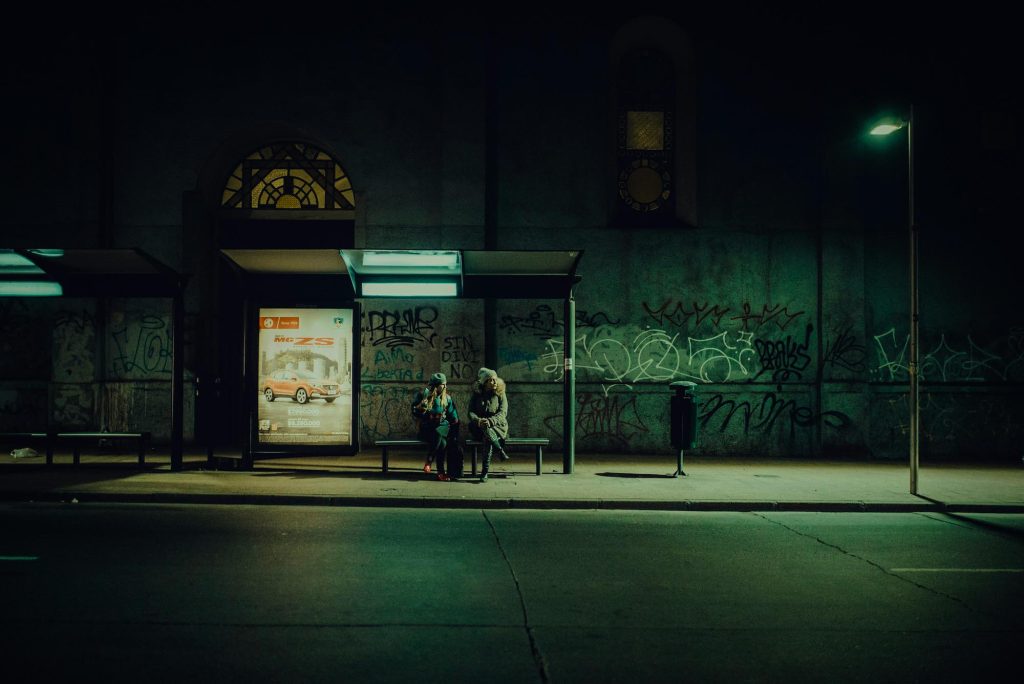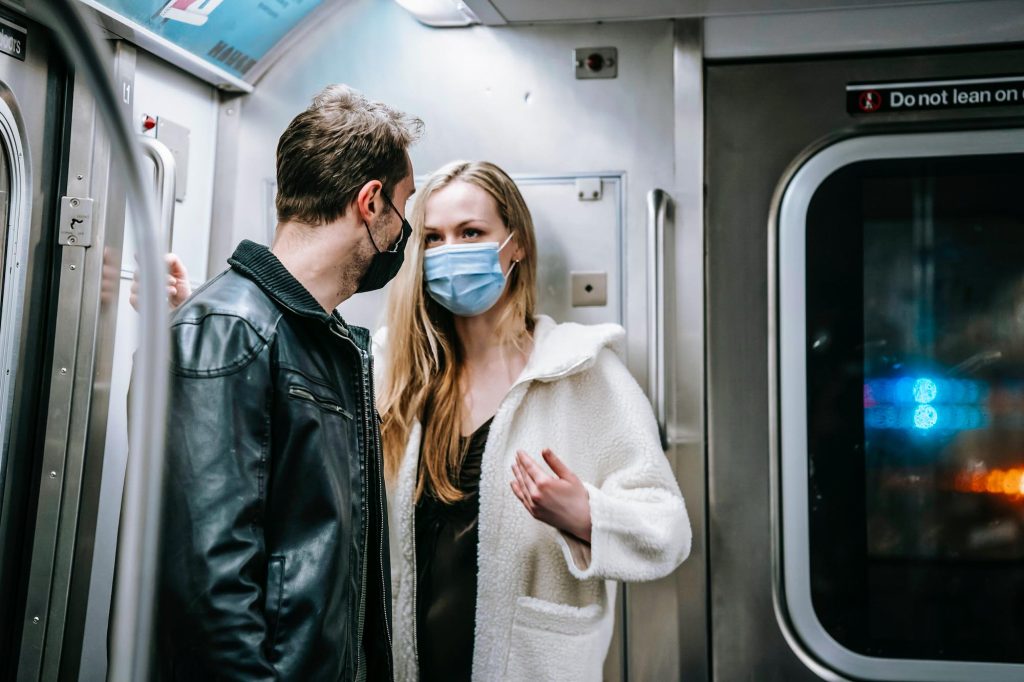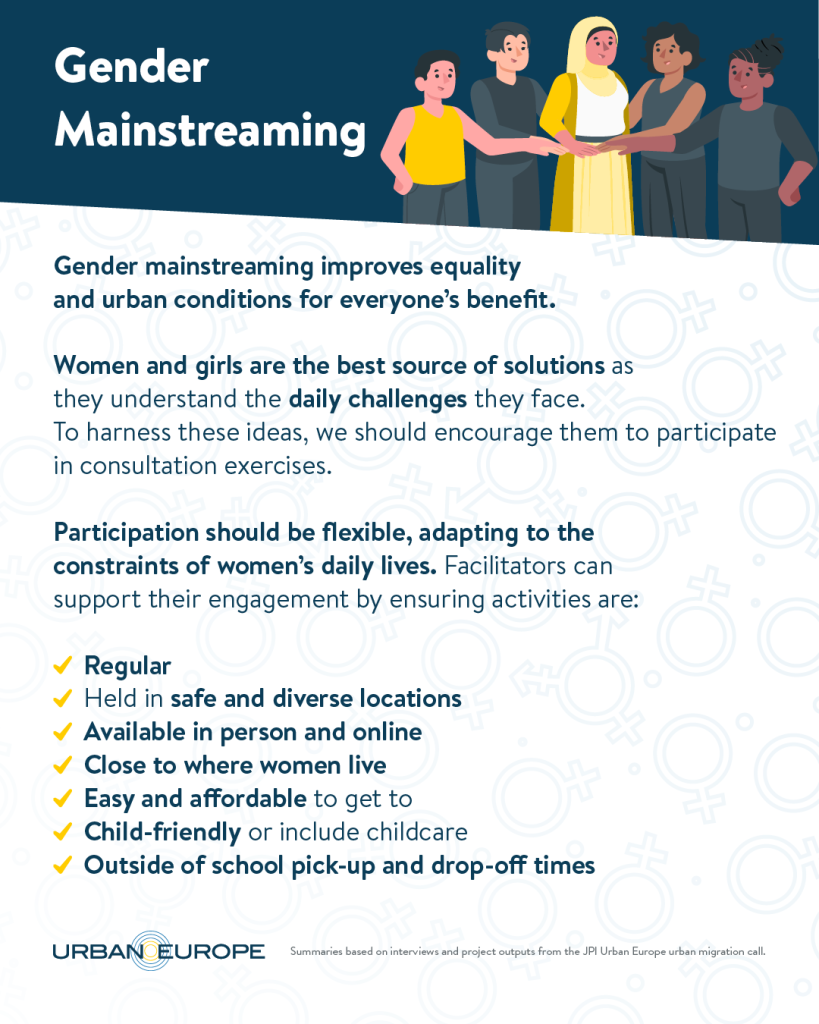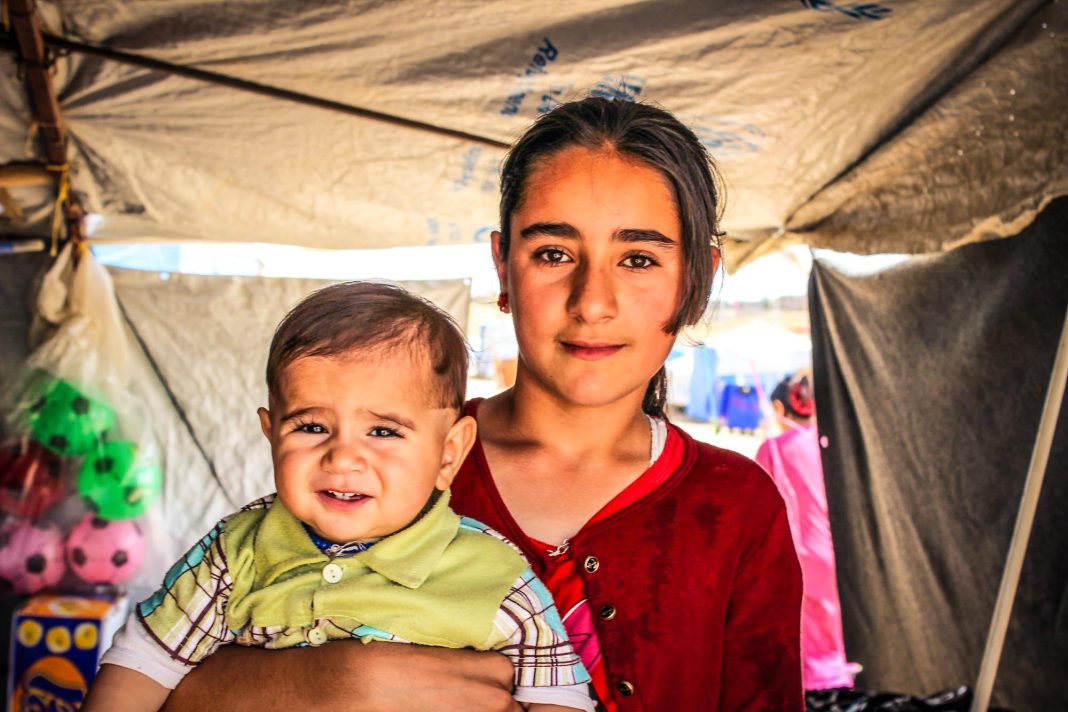It’s a fact! Cities are designed by men for men. This skews power relations in the built environment and the systems that govern them, curtailing women’s social and economic mobility. Added to this, intersectional factors – and for migrants the specifics of a legal status – can exacerbate the exclusions that non-male residents come up against. Gendered issues feature heavily in the findings of the projects that JPI Urban Europe commissioned to research the reciprocal relationship between migration and the function of urban spaces. The purpose of this article is to bring these findings together and to serve as a basis for authorities and communities to recognise the situation in their own city and for formulating solutions that enhance equality.
A year after the start of the war with Russia, women accounted for 70% of Ukrainians seeking refuge in other European countries (the rest were children). This is an unusually high proportion. In 2018, females accounted for fewer than half (45%) of migrants in Europe overall and in 2022, 71% of the EU’s asylum claimants were men. Along some of the main entry routes into Europe by land and sea – the Eastern (Greece, Cyprus, and Bulgaria), Central (Italy and Malta), and Western (Spain) Mediterranean routes and the Western African Atlantic route – only 14% of arrivals in 2020 were women.
This affects the way we support migrants of different genders but maybe even the root of this imbalance is gendered too.
Who is the Female Migrant?
Not all migrants are forced. Some families, if they can afford it, take the chance to send one unaccompanied relation abroad to safety. Joanna McIntyre explains that more often than not they’ll choose a man or boy.
“It’s more likely that a male is going to be able to survive,” she tells us. “They’re not as likely to experience sexual harassment.” They are also usually considered the most likely to earn the money needed to pay for the other family members to join them later (chain migration).
Joanna’s research project, The Art of Belonging, used creative tools and participation in cultural placemaking to investigate the relationship between art and social integration. In Nottingham, UK, many of the participants in the project were unaccompanied – and male. They had the confidence to attend workshops alone, whereas young women only came towards the end of the project, and always in groups.
Contrast this to the second location – Lund in Sweden – where all but one of the participants was female. Whole Syrian families had settled in the city, increasing the presence of migrant girls, but their attendance still very much depended on the project leaders having the trust of their families – their choice was much less independent.
This feeds into the notion that the typical ‘image’ associated with a migrant is male; women are likely thought of as dependents: powerless, victims, voiceless.

Female Migrants’ Intersectional Experiences
Another important finding of the research is about how gender disparities show themselves in the form of social and institutional discrimination. Infrastructure for women migrants lags far behind that for men.
Sharing their experiences with HOUSE-IN during a meeting also in Lund, a group of female refugees from Ukraine, Latin American and African nations, Syria, and Palestine exposed the intersectional disadvantages migrant women face after arrival.
HOUSE-IN assessed the impact that innovative, inclusive housing strategies have on linking housing and migrant integration, identified the gaps, and looked at what stimulates co-creation to fill them. “The obstacles come together and reinforce each other,” Annegret Haase tells us. For example, “being a woman, being a refugee, and being a vulnerable person in another country”.

Female new arrivals receive less support for accessing employment and language learning, opening up a chasm between genders in their chances for integration.
In London, a lack of available spaces for language courses is a real issue. Those worst affected by poor English comprehension – and the exclusion this imposes – are older women who have already been resident for 20 years or more. They have often spent this time childrearing. So, while they may be active in their own cultural community, they are segregated from wider society.
Even those who have learnt the language seem to prefer for male relatives to call services or make complaints on their behalf, for fear of being taken advantage of or not taken seriously.
Voiceless in the Household
For female-led households, private landlords (as seen in Birmingham, UK) are more than occasionally guilty of charging higher rates for women than for men, even for substandard accommodation – a practice called ‘rent exploitation’. Women are also less likely to voice a complaint.
Even within families, discrimination is rife.
Evidence seen in Germany, Sweden, and the UK proves that budgeting and other household decisions are dominated by husbands, brothers, sons, and even male in-laws.
Still, many settled female migrants involved in the EMPOWER research arrived in the study cities alone. This project investigated the impact community-led infrastructures and place-making strategies have on female residents. Those they interviewed see the public sector as a regulated and safe environment where they would be treated fairly and sympathetically. This is to be celebrated, but when social housing is being assigned to those who could access the private market (e.g. wealthier individuals), it contributes unnecessary demand for limited stock.
Collaborative housing might provide one alternative that suits these women very well.
The MICOLL project investigated how co-housing might provide gender-sensitive accommodation options where migrant women can be close to people they trust. The sense of community, security, safety, and belonging that the model offers is thought to alleviate some gender-based trauma.
The Problems Mount Up
But there’s more – a lot more! – that female migrants contend with that unfairly impacts on their agency, freedoms, and life experiences in the city:
- gender norms (e.g. domestic chores, raising children, caring responsibilities)
- expectations from family members
- sex discrimination
- the pay gap
- insufficient pre- and post-natal care
- pregnancy and the fees associated with childbirth
- vulnerability to risk of exploitation and abuses
- increased fear of crime when moving about the city (e.g. tunnels, parks, unlit streets)
- gender-based violence.
Women can even encounter greater difficulties in having their qualifications recognised internationally!
Limited opportunities, poor living conditions, the prospect of discrimination in the labour market, and transport and access struggles were concerns raised time and again by females throughout the research.

The Gendering of Access
Picking up on the point about mobility: EMPOWER also heard from participants how safety fears impinge directly on their chances to engage with activities and services. The knock-on effect is that women are prevented from social mixing and essential support.
Where engagement seems better, is with the presence of female support workers. Women put more trust in a female clinician, for example. For their part though, health professionals have noticed that migrant women who do not speak the local language rely heavily on male relatives to act as interpreters. Throw cultural sensibilities or situations of domestic abuse into the mix and we can conclude how this causes a barrier to a clearly communicated presenting issue – and therefore an obstacle to getting the care they need.
Simon Pemberton spoke of one (unnamed) civil society organisation in Sweden that has grown wise to this.
They council migrants on a series of issues: food, housing, health, education, etc. Sometimes female clients are accompanied by male relatives who dominate the discussion. In these cases, a staff member distracts the relatives by asking them for help with an issue elsewhere, creating space for the woman to open up. This distraction technique is one time the migrant trait of being (overly) polite and respectful to authority figures – as Joanna McIntyre has observed – pays off.

The Invisible Migrant: An Issue of Accommodation
But what of the migrants that fail to engage with services at all, or fall through the cracks?
Destitute migrants can easily end up homeless. However, this should not be confused with rough sleeping.
Women are more likely to avoid sleeping on the streets for as long as possible for their own safety – although this confidence may be misplaced.
When they turn to informal networks – friends and family – for a room, bed, or sofa, migrants are more likely to be ‘invisible’, effectively unknown to the authorities. They become harder to support and vulnerable to trafficking, exploitation, and other abuses. It’s the same story for those who rely on their employers for a room in private households. Women with a precarious migration status can often end up in this situation and having children or being pregnant increases the risks.
LoReMi reminds us that transgender and intersexual persons living in precarity face similar vulnerabilities. That project looked specifically at the needs of precarious migrants with the aim of strengthening local strategies to address how they are excluded. So, naturally there was a focus on women.
In Vienna, the research showed that significantly more men than women access homeless shelters (often sharing rooms, compromising privacy). Fewer places are therefore made available for women, perpetuating their exclusion and exacerbating existing vulnerabilities.
Why Shelter is the Wrong Name
Asylum seekers are usually accommodated in shelters or hotels. (Often, they have no choice over where or for how long.) The ever-present prospect of being moved on undermines chances to develop meaningful local connections – geographically or socially. When the time comes, they are often forced out at short notice, such as when their asylum decision is finalised.
In the research, some women described how they fear what’s outside the shelter and rarely venture far. The isolation of socio-spatial segregation has repercussions for mental and physical wellbeing. It’s not much better indoors: in mixed-sex shelters, women are more vulnerable to sexual and gender-based violence.
Shelters are also known to be overcrowded, busy, and noisy. Women report that this can impair their children’s ability to get the most from their homework or other interests. They expressed a desire for safe meeting places and activities for young people, which are rarely taken into account in the planning of these shelters.
Is Integration Gendered?
Even so, interviews with stakeholders and migrants identified how social links blossom much more among females than men. Given the right environment, female migrants make greater use of opportunities to integrate with a diverse community, regardless of their former traumas and attitudes towards risk, implying that conviviality and solidarity are gendered motivators for ‘reclaiming the city’.
This has a positive knock-on effect.
MAPURBAN conducted research into ways to improve migrants’ access to essential urban resources and participation in urban society. Their report states: “Sharing knowledge about places and getting to know new places was empowering for the women in dealing with their neighbourhood.”
Guidance for Cities
So there are up sides to being female for migrants. And for all the talk of challenges, it stands to reason that plenty can be done to turn the situation around. A good place to start is to simply improve awareness of these issues and of what local support is on offer. But a city serious about equality can do a whole lot more.
Active Listening
Encouraging greater participation among vulnerable groups helps municipalities understand local conditions and their needs.
Previous research suggests that some municipalities are open to involving female migrants in consultation and place-making but are reluctant to give them direct access to (or “intervene in”) design and delivery. To work, this requires trust and commitment from both sides.
That’s where public, voluntary, and community sector service providers can mobilise to bridge the gaps. However, it cannot be, as was noted in some cases, left to the few specific individuals who are familiar with hard-to-reach communities. Institutionalising best practice is required to ensure consistency and to provide chances for migrants themselves to initiate engagement.
What this really comes down to is that gender mainstreaming should be a priority in every city and this involves a lot of common sense!

Plan with the Most Vulnerable in Mind
Cities that cater for the needs of the most marginalised are better for all citizens.
Urban planners, policymakers, and housing groups should be encouraged – and trained – to involve stakeholders from all backgrounds, inequalities, and lived experiences.
Engagement with superdiverse neighbourhoods particularly can lay the foundations for a cross-cultural spectrum of services.
Representation
ProSHARE enlisted and trained a diverse group of local women as ‘community researchers’, each with a background reflecting the migrant groups they interviewed.
The people they spoke to were more open and honest with individuals who represented their own diversity of age, gender, and life and migration trajectories. This provides valuable data that feeds more targeted solutions.
Encourage a Sense of Community
Studies have shown how community groups that offer learning and information exchanges empower migrant women to grow and improve their political activism, relationships, and communication skills.
As such, local authorities should encourage inter-group mixing to strengthen social connections and local networks.
This can be done through the creation and sustaining of local groups by:
- offering resources, funding, expertise, and links to local actors
- creating a public database for volunteer sign-ups
- covering travel costs for individuals to attend
- compensating for the time voluntary and community sector organisations spend organising/coordinating meetings
- providing convivial, safe spaces where women feel physically and psychologically comfortable to talk about their issues
- promoting local services and meetings using posters in different languages at suitable locations (e.g. healthcare facilities)
- establishing female-led and/or female (and mother) only groups that address rights and responsibilities from a women-centred perspective.
But the first thing cities need to do is to acknowledge women’s experiences are different to men’s, and how this makes navigating a city even harder for female migrants.
Adopting a gendered lens may be the first step municipalities need to take towards forming possibilities for sustainable, positive change that improves every aspect of life for their most vulnerable residents – and everyone else besides.
Note: This article is commissioned by and produced in collaboration with JPI Urban Europe, a European research and innovation hub founded in 2010. JPI Urban Europe funds projects which address pertinent global urban challenges. Between January 2021 and January 2023, their support enabled eight projects to explore the concepts of urban migration and integration. CityChangers.org has partnered with JPI Urban Europe to make the findings of these research projects more tangible and accessible to a wider audience. More details about the Urban Migration call can be found on the JPI Urban Europe website. The original version of this article is published here.


